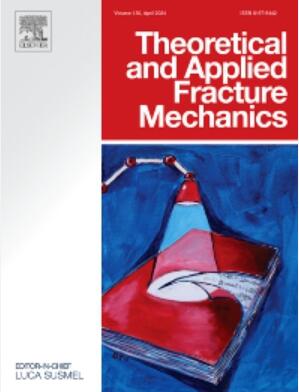Cracking evolution and failure mechanism of brittle rocks containing pre-existing flaws under compression-dominating stresses: Insight from numerical approach
IF 5
2区 工程技术
Q1 ENGINEERING, MECHANICAL
引用次数: 0
Abstract
Comprehending the cracking evolution and failure mechanism of flawed rocks under compression-dominating stresses is essential to evaluating the stability of rock engineering. In this work, a newly developed geometry-constraint-based non-ordinary state-based peridynamic (GC-NOSBPD) theory that can eliminate the numerical oscillation is applied to predict the development of new cracks of flawed rocks under compression-dominating stresses. The failure of bonds between particles is judged by the bond-associated stress-based fracture criteria. The cracking evolution trajectories of semi-disc and disc specimens containing flaws are traced. The effects of flaw inclination angle on the cracking trajectories are analyzed. The cracking evolution paths of rock-like specimens with two flaws under uniaxial and biaxial compression are molded. The effects of confining stress on the growth of new cracks are investigated. The confining stress restrains the propagation of tensile cracks, but it is easy to promote the growth of shear cracks. The concentration and transfer effects of stress can plainly revel the failure mechanism of flawed rocks. The present numerical method is reasonable to predict the tensile and shear failure modes of flawed specimens under compression-dominating stresses.
在压缩主导应力作用下,含有已存在缺陷的脆性岩石的裂缝演变和破坏机制:数值方法的启示
要评估岩石工程的稳定性,就必须了解缺陷岩石在压缩应力主导下的裂缝演变和破坏机理。在这项工作中,新开发的基于几何约束的非平凡状态围岩动力学(GC-NOSBPD)理论可消除数值振荡,用于预测压缩主导应力作用下有缺陷岩石新裂缝的发展。颗粒间结合的破坏是通过基于结合应力的断裂标准来判断的。对含有缺陷的半圆盘和圆盘试样的裂缝演变轨迹进行了追踪。分析了缺陷倾角对开裂轨迹的影响。在单轴和双轴压缩条件下,模拟了带有两个缺陷的类岩试样的裂纹演变轨迹。研究了约束应力对新裂缝生长的影响。约束应力抑制了拉伸裂纹的扩展,但容易促进剪切裂纹的生长。应力的集中和传递效应可以清楚地揭示有缺陷岩石的破坏机理。本数值方法可合理预测缺陷试样在压缩应力主导下的拉伸和剪切破坏模式。
本文章由计算机程序翻译,如有差异,请以英文原文为准。
求助全文
约1分钟内获得全文
求助全文
来源期刊

Theoretical and Applied Fracture Mechanics
工程技术-工程:机械
CiteScore
8.40
自引率
18.90%
发文量
435
审稿时长
37 days
期刊介绍:
Theoretical and Applied Fracture Mechanics'' aims & scopes have been re-designed to cover both the theoretical, applied, and numerical aspects associated with those cracking related phenomena taking place, at a micro-, meso-, and macroscopic level, in materials/components/structures of any kind.
The journal aims to cover the cracking/mechanical behaviour of materials/components/structures in those situations involving both time-independent and time-dependent system of external forces/moments (such as, for instance, quasi-static, impulsive, impact, blasting, creep, contact, and fatigue loading). Since, under the above circumstances, the mechanical behaviour of cracked materials/components/structures is also affected by the environmental conditions, the journal would consider also those theoretical/experimental research works investigating the effect of external variables such as, for instance, the effect of corrosive environments as well as of high/low-temperature.
 求助内容:
求助内容: 应助结果提醒方式:
应助结果提醒方式:


